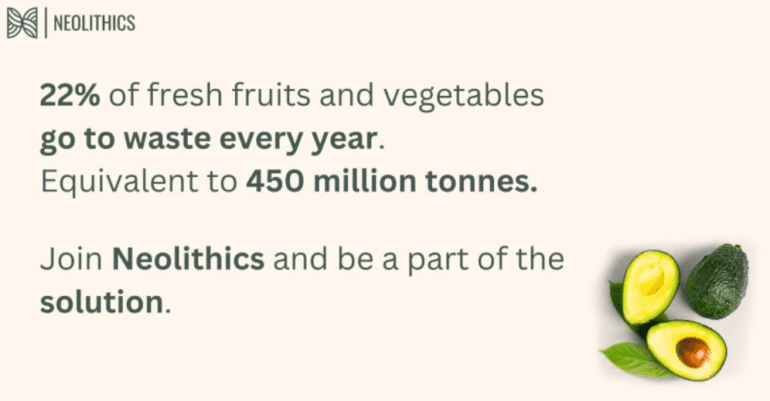TL;DR:
- Neolithics employs AI machine learning to combat global food waste through innovative technology.
- UN Food and Agriculture Organization cites 1.3 billion tons of wasted food annually, costing $1 trillion and impacting the environment.
- Neolithics’ Crystal.eye™ utilizes hyperspectral imaging and AI to enhance quality control for fresh produce.
- Crystal.eye™ captures unique characteristics, enabling rapid analysis of attributes like firmness, moisture, and acidity.
- The system empowers growers and distributors to increase sampling accuracy from 1% to 30-40%.
- Neolithics’ emphasis on food science sets it apart, addressing both exterior and interior produce qualities.
- Crystal.eye™ expands to predict produce maturity cycles and detect pesticide residues.
- Neolithics aims to reduce food waste, enhance safety, and improve distribution, aligning with sustainability goals.
Main AI News:
In an era where sustainability and efficiency reign supreme, addressing the monumental issue of global food waste has become paramount. Although an often-overlooked concern, the magnitude of discarded food due to quality standards not being met or spoilage during transit is staggering. The UN Food and Agriculture Organization reveals an alarming statistic – a colossal 1.3 billion tons of food are wasted annually, translating to a staggering $1 trillion loss in the global economy. The repercussions are not confined to finances; the environmental toll is profound, with food wastage contributing to a staggering 3.3 billion tonnes of CO2 emissions and requiring an expanse of land equating to approximately 1.4 billion hectares.
With the global population set to reach an estimated 10 billion by 2050, the challenge of sustaining such a populace is dire. The fulcrum of this endeavor rests on the transformation of the food industry, an imperative that includes a paradigm shift in food waste reduction.
Yet, combating food waste is a multifaceted endeavor. The stringent demands of retailers and consumers necessitate uncompromising quality control measures, leaving no room for subpar products. Balancing this with efficient methodologies is challenging; archaic manual inspections are prone to subjectivity and inefficiency, even in today’s era. An innovative approach is essential – one that leverages cutting-edge technology to streamline the process.
Enter Neolithics, a pioneering agritech enterprise hailing from Israel. Fueled by the power of artificial intelligence and machine learning, Neolithics’ solution, christened Crystal.eye™, is a beacon of hope in the fight against food waste. Operating on the bedrock of optical sensing, this technology orchestrates a symphony of automation and quality enhancement for fresh produce. Its adaptability and versatility enable a range of configurations, catalyzing optimal utilization while minimizing waste.
Crystal.eye™ shatters the constraints of conventional visible light with its ingenious application of hyperspectral imaging, encompassing over 400 light spectra. This mastery of light penetrates deep into fruits and vegetables, negating the need for destructive cutting or grinding. The resultant images yield a distinct fingerprint, a trove of information meticulously decoded by Neolithics’ corps of food scientists. Attributes such as firmness, moisture content, sugar levels, and acidity are meticulously identified, with the data harnessed to fuel an AI machine learning engine. In a matter of seconds, the system orchestrates the analysis of expansive sample batches, a feat that would have been unimaginable through manual means.
The culmination of this process manifests in real-time visualizations on a digital dashboard, complete with tailor-made reports attuned to the unique requisites of each client. For instance, manufacturers of French fries seek insight into potato dry matter, while vintners crave precision in grapes’ acidity and sweetness for the perfect flavor bouquet.
Crystal.eye™ propels growers and distributors beyond the confines of conventional sampling, expanding from a paltry 1% to a remarkable 30% to 40%. This surge in accuracy dramatically curtails the likelihood of produce failing to meet consumer demands, a testament to the prowess of Neolithics’ innovation.
Wayne Nathanson, the Vice President for Global Development at Neolithics, underscores the bedrock of their success – expertise in food science. Distinguishing Neolithics from its counterparts, Nathanson elucidates that while hardware exists for sorting produce, these technologies typically focus on external attributes, leaving the interior uncharted territory. Neolithics’ edge lies in its contingent of expert food scientists, adept at harnessing the wealth of information gleaned from each produce.
Presently, Crystal.eye™ champions the assessment of produced content and defects, offering clients an array of internal and external attributes. Already embraced by an escalating number of growers, distributors, and food processors, the solution continues to evolve. Anticipated updates will encompass the assessment of produce maturity cycles, fortifying customers’ ability to predict spoilage. The horizon also holds promise for the detection of pesticide residues and proscribed chemicals on produce, set for release in the near future.
“Sustainability is our lodestar,” declares Nathanson, crystallizing Neolithics’ unwavering commitment. The mission – a reduction in food waste and an elevation of food safety – resonates profoundly. The harrowing knowledge of daily food waste fuels Neolithics’ dedication to annihilating wastage along the supply chain, eradicating the need for destructive inspections. The aspiration extends to bridging the chasm between supply chain links, ensuring that more consumable quality produce reaches the end consumer. A stark reality underscores the urgency – 1.3 billion tons of annual food wastage juxtaposed against a world where nearly a billion people grapple with hunger. Nathanson’s words reverberate: “We believe there’s an opportunity to feed more people with the food that is thrown out. This becomes more and more critical, the closer the world population gets to the 10 billion mark.”
Conclusion:
Neolithics’ innovative use of AI and hyperspectral imaging to address food waste presents a significant disruption to the market. Their Crystal.eye™ solution not only enhances quality control but also enables a more sustainable approach to feeding a growing global population. This could reshape the industry by reducing waste, increasing efficiency, and elevating the standard for produce quality.

